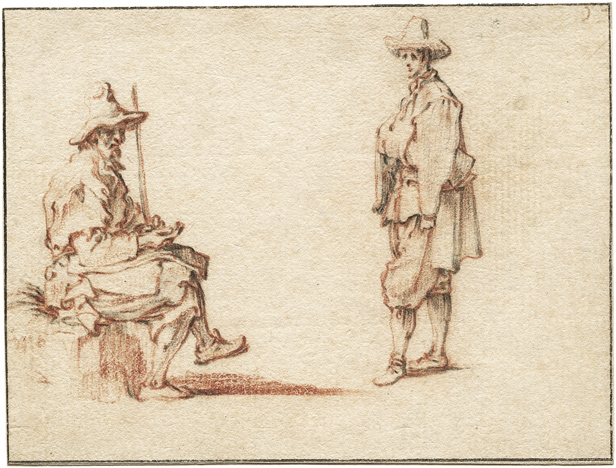Loading the page ...
Jacques Callot
(1592–1635, Nancy)
Study Sheet of a Man with a Staff Sitting on a Rock and a Man Standing to his Left. Red and black chalk, borderline in pen and black ink. 8.3 x 11 cm. A. Blunt, The French Drawings at Windsor Castle, London 1945, p. 20 and no. 31; D. Ternois, Jacques Callot: Catalogue complet de son oeuvre dessiné, Paris 1961, no. 397.
Jacques Callot was a most talented and highly prolific draughtsman, as is evidenced by this small but artistically very compact study sheet. Having arrived in Florence in late 1611, Callot spent the first few years of his stay there attempting to perfect his drawing skills under the supervision of Giulio Parigi. His efforts paid off when, in the autumn of 1614, he was granted official membership of the Grand-Duke’s “Galleria” and given a workshop in the Uffizi. Callot subsequently devoted himself almost exclusively to etching. The present study sheet was probably produced between 1617 and 1619 in Florence.
In stylistic terms it follows on a group of figure studies made in conjunction with Callot’s chef d’oeuvre, the etching of the Fair at Impruneta (Lieure 361). This large-format piece, published in 1620, ranks among Callot’s most ambitious creations and is conspicuous for its lavish composition and the large number of staffage figures portrayed in a wide variety of poses and situations. Callot demonstrated great prudence in the preparation of this printmaking masterpiece. During several journeys to Impruneta he drew countless detail studies in situ, not all of which were eventually used, however (see D. Ternois, op. cit, nos. 251–301). All these preparatory studies, the majority of which are in the Uffizi in Florence, have an almost uniform sketchbook format and were executed in red chalk or in a combination of red and black chalk. These studies, which Callot appears to have dashed off quite effortlessly, are impressive proof of his consummate drawing skills and unerring instinct for succinct characterisation.
Provenance: Possibly Paignon-Dijonval; Thomas Dimsdale; Lord Amherst (Sotheby’s, London, 14 December 1921);
Sir Robert Witt; through bequest Sir John Witt (Lugt 646a; Sotheby’s, London, 19 February 1987, no. 263).
